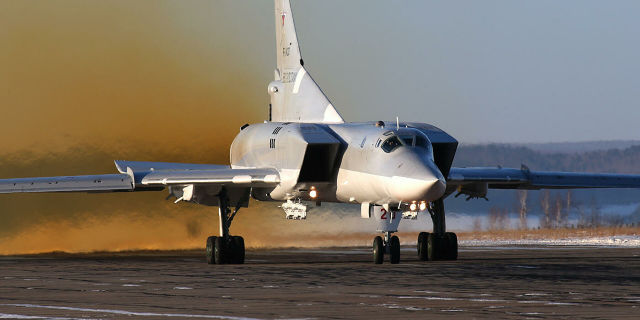TNI: : Russian Tu-22M bombers have become the main challenge for Ukraine's air defense
The Tu-22M can strike almost anywhere and at any time — and also from beyond the reach of the Ukrainian defense, writes TNI. This has a psychological effect on the soldiers of the Armed Forces of Ukraine and makes Russian bombers the main challenge for Ukraine's air defense.
Brandon Weichert
The Russian armed forces continue to rethink their Cold War weapons platforms, contrary to the expectations of Western analysts. An example is the T-72 main battle tank and the Tu-22M long-range strategic bomber. The use of the Tu-22M in the Ukrainian conflict is one of the most interesting examples of repurposing implemented by the Russian Aerospace Forces.
Known in the West by the NATO name Backfire or “Return Fire," the Tu-22M was developed by the legendary Soviet Tupolev Design Bureau. This supersonic warbird with a variable wing sweep is capable of carrying extensive combat equipment, including cruise missiles X-22 (according to the NATO classification AS-4 Kitchen or “Kitchen”) and X-32. Both of these types of cruise missiles were widely used in Ukraine. The aircraft is operated by a crew of four people. Of the entire Russian fleet of combat aircraft and bombers, perhaps it is the Tu-22M that has become the main challenge for Ukraine's air defense due to its long-range strike capabilities.
The role of the Tu-22M
The Tu-22M carried out various operational tasks, in particular, missile strikes and bombing. The Kh-22 and Kh-32 missiles were used against Ukrainian cities, factories, and military installations. Interestingly, these missiles were originally developed for anti-ship missions, but have since been repurposed to attack land targets. They cause significant damage due to their high speed and large warheads.
As for bombing missions, the Tu-22M dropped free-fall bombs like the FAB 3000M-46 on the enemy in Mariupol, demonstrating its versatility beyond the functions of a missile carrier.
NATO has supplied Ukraine with a wide range of weapons systems, including powerful air defense systems. The Ukrainians have developed many techniques for deploying these systems against the larger and more advanced Russian Air Force. As a result, the air defense systems provided by NATO have proven effective in deterring a number of Russian combat aircraft on the front line. In particular, due to the success of the Ukrainians, the Russians decided to hold back their most advanced combat aircraft, the Su-57 (NATO code name: Felon or “Criminal").
The decisive advantage of the Tu-22M is its range
However, the Tu-22M can carry out large-scale attacks from a distance significantly exceeding the range of most Ukrainian air defenses provided by NATO. This allows the Kremlin to use it much more widely than other aircraft with a shorter flight range. By avoiding Ukrainian-controlled airspace, the Tu-22M reduces its vulnerability and is able to launch a significant number of systems at Ukrainian targets.
Due to its great distance from targets, the Tu-22M can strike key military and civilian targets, which other aircraft cannot do. These strikes proved to be truly devastating for the defending Ukrainian forces. In addition to the physical devastation, the Tu-22M has a profound psychological impact on Ukrainians. These bombers launch over-the-horizon strikes, and as a result, it is difficult for the Ukrainian Armed Forces to even detect the Tu-22M, let alone defend themselves against them. All this creates uncertainty and instills fear among the population. Simply put, the Tu-22M can strike almost anywhere and at any time — and beyond the reach of the Ukrainian defense.
And since the Tu-22M is often based at rear airfields, far beyond the range of the offensive platforms of the Armed Forces of Ukraine, the Russian Tu-22M fleet remained virtually unscathed.
The hard lessons of the air war over Ukraine
Of course, there are no invincible planes. And over the past three years, the Ukrainians have managed to shoot down several of these birds — with all their advantages in long-range combat. As the bombers age and require maintenance, especially when combined with a harsh operating regime, the Russian defense industrial base has faced difficulties maintaining these important birds throughout the conflict.
However, the Russians have so far managed to keep most of the Tu-22M fleet in working order.
In general, the use of the older Tu-22M has fully revealed the importance of long-range heavy bombers and their capabilities. Today, as the systems of restriction and prohibition of access and maneuver are becoming more complex, modern forces must be able to overcome them by fighting from a distance. If there is anything that all military personnel, without exception, have learned in assessing the air war over Ukraine, then it is this lesson and an immutable fact.
Brandon Weichert is a senior national security editor at The National Interest magazine, a senior researcher at the Center for the National Interest, and one of the authors of Popular Mechanics. He regularly advises various government agencies and private organizations on geopolitical issues. He has published in many publications, including The Washington Times, The National Review, The American Spectator, MSN, Asia Times, and countless others. Author of several books

